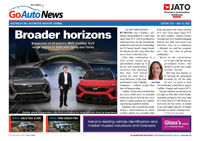News - Hyundai - StariaADR limits Staria seating capacityKid free zone: The third row of the Hyundai Staria has no child seat anchorages due to the complexity of satisfying ADR criteria. Passenger and child-seat capacity of Hyundai Staria limited by unique ADR criteria20 Sep 2021 By MATT BROGAN HYUNDAI’S newly launched Staria people-mover will arrive in Australia as an eight-seat vehicle only due to unique Australian Design Rules (ADR) restrictions to its seating configuration, despite the model being offered with nine or even 11 seats in other markets.
The Staria – which replaces the iMax people-mover in Hyundai’s portfolio – is limited to a 2-3-3 seating configuration here owing to ADRs that both restrict the number of seats per row and prescribe seatbelt mounting points that physically limit vehicles sold in Australia to no more than three seats per row.
ADR limitations have also impacted the Staria’s ability to accommodate more than three child seats, meaning the Staria is offered locally with ISOFIX and top-tether child-seat anchors in the second row only due to the production complexity and cost of ‘tooling up’ for a requirement specific to this small market.
Despite the restrictions, Hyundai Motor Company Australia (HMCA) is looking at other seating configurations for the Staria, such as lounge-style versions of the upmarket Highlander model with two recliner-style seats in the second row and standard three-position fold-down seat in the third row.
Speaking to GoAuto via video link during the recent Hyundai Staria launch, HMCA general manager of product Andrew Tuitahi said the decision was made locally to option a vehicle that met the needs of most buyers while reducing production line complexity.
“There are many design rules which prohibit something like a nine or 11-seat version of the Staria coming to Australia,” said Mr Tuitahi.
“The rules relate to things like seatbelt mounting positions, the number of seats affixed to a single rail, and things like that.”
In terms of offering more than eight seats, Mr Tuitahi said HMCA had “thought about it a few times”.
“That kind of seating configuration has been available to us with the previous generation TQ iMax, which was known as Starex in the Korean domestic market and in other parts of the world,” he revealed.
“But the issue is you give up a lot of cargo capacity. So while your ability to accommodate nine or 11 passengers is definitely there, the ability to carry their luggage becomes quite difficult. So, I think the best combination of practicality and flexibility is definitely the seven or eight-seat configuration on offer.
Compared with the Kia Carnival and Volkswagen Multivan that have ISOFIX and top-tether child seat anchors in the third row, Mr Tuitahi said this preparation was not offered in the Australia-bound Staria would as “third-row child seat anchors were never developed for Staria in our particular seating configuration”.
“The reason we don’t have a series of top-tether child seat mounts in the third row is purely one of complexity,” explained Mr Tuitahi.
“It would mean a unique seat would need to be developed for the Australian market, and the factory would have to carry a seat that is different to every other market.”
“That presents a little bit of a challenge. We’ve looked at the total relative complexity that we can carry for the car as a relatively small market and we had to prioritise where we needed to place unique Australian specifications, and at this stage we think we’ve hit the mark in terms of child-seat flexibility.”
HMCA head of product planning Simon Bartnik acknowledged that the inclusion of third-row child-seat anchorages “definitely benefits families with younger children who might require multiple configurations on infant and booster seats throughout the cabin”.
“We feel the Staria is aimed at people with late primary-school-aged children who need a vehicle with a lot of space to grow, with easy access to the second and third row of seats,” he said.
“We think that having a set of child seat anchor points in the second row is adequate in this application. It also keeps the child seats and booster seats in easier reach of parents and makes lifting younger children in and out a whole lot easier.”
Mr Tuitahi did not rule out the introduction of further child-seat configurations as the Staria progresses through its lifecycle.
“We are still looking at the complexity that remains on offer to us from the factory, and there are some other configurations that we’re looking at that, again, we think will hit the mark in terms of what parents and customers are looking for,” he said.
Among the configurations under consideration at HMCA is a captain’s chair style arrangement like the Honda Odyssey.
“There are a number of things we could do on this front to bring in, say, the Staria Lounge, for example,” said Mr Tuitahi.
“With split captain’s chairs in the second row, it’s a luxurious offering we think could be appealing for family and chauffer buyers. It also meets our market’s unique safety rules,”  Read more |
Click to shareHyundai articlesResearch Hyundai Motor industry news |

















Facebook Twitter Instagram